If all goes right, the construction project shaping up at Oweekeno (Rivers Inlet) can serve as a blueprint for future partnerships between First Nations people and city folk all across Canada. This project brings together a wide variety of rural and urban groups, companies, government agencies and private individuals all with a common purpose – to build community.
 Oweekeno is located on the banks of the Wannock River at the entrance to Owikeno Lake east of Rivers Inlet, south of Bella Bella on the BC coastline. It’s so small and remote the village is hard to find on a map. Oweekeno is home to the 280 members of the Wuikinuxv Nation, many who live off-reserve in other areas of the province. The Wuikinuxv have an affiliation with the Oweekeno/Kitasoo/Nuxalk Tribal Council in Bella Coola.
Oweekeno is located on the banks of the Wannock River at the entrance to Owikeno Lake east of Rivers Inlet, south of Bella Bella on the BC coastline. It’s so small and remote the village is hard to find on a map. Oweekeno is home to the 280 members of the Wuikinuxv Nation, many who live off-reserve in other areas of the province. The Wuikinuxv have an affiliation with the Oweekeno/Kitasoo/Nuxalk Tribal Council in Bella Coola.
Currently the reserve hosts a band administration office, a health centre, a K-7 school, a fire hall, an airstrip, and a newly constructed ceremonial “Big House” used for cultural purposes. Soon, however, the community will be the proud owner of a new multi-purpose flex court to be used for healthy recreational activities such as basketball, volleyball, ball hockey and tennis. This new facility is a cooperative venture between the rural Wuikinuxv and “city folks” organized under the direction of Rotarian Bob Blacker, former Regional Governor of Rotary District 5040, currently working in conjunction with His Honour Stephen Point, the Lt. Governor of BC and his new Aboriginal Literacy Project.
“This is a enormous project,” says Blacker, “and its quite a challenge to bring it all together. We’ll be doing the construction sometime this fall, I hope, when all final pieces fall in place.”
 Architect Scott Kemp has drawn up plans for a covered 88 by 110-foot flex court, sitting on a cement pad and covered by an iron roof, thereby functional the entire year. The court will be surrounded by bleachers and a new library will be situated at one end where parents can watch their kids play, read books and socialize. While the community already has a Big House for formal purposes, the new development is intended to act as a community centre, bringing everyone together.
Architect Scott Kemp has drawn up plans for a covered 88 by 110-foot flex court, sitting on a cement pad and covered by an iron roof, thereby functional the entire year. The court will be surrounded by bleachers and a new library will be situated at one end where parents can watch their kids play, read books and socialize. While the community already has a Big House for formal purposes, the new development is intended to act as a community centre, bringing everyone together.
The libraries will be equipped with computers, where children can learn to become computer literate under adult supervision. But once a cyber-connection between the reserve and outside world is established, and interested parties brought together via email and video, who knows what other connections can take place?
The list of participating partners is endless. First is key sponsor Britco Structures of Langley, which has already offered to donate ten portable modular 44 by 10-foot buildings to be used as libraries and community centres on First Nation reserves around the province. The 10 modular buildings represent a $500,000 donation on the part of Britco, who will also assist with delivery of the buildings to their remote sites.
Getting a 44-foot building to a remote location like Oweekeno is just one of the many unique challenges Blacker has faced. Finding the right type of barge to off-load at the beach is one major task. Right now, Seaspan of North Vancover has offered to help with the delivery of the building, but how do you get cement, logs, rebar, a mixing plant and other materials also shipped to such a remote place?
“We’ve had offers from Western Forest Products and Interfor to help find the right size of logs,” says Blacker. “The value of the logs they are donating is over $65,000. We’ve been looking for logs up to 110 feet long, and they finally found them. The community will do the milling, cutting the logs into 4 by 12-inch sections 45 feet long. We need 6 posts 48 wide and 16 posts 36 inches wide and two beams 110 feet long and 48 inches wide just to hold up the roof.”
Then there is the question of cement. It will have to be shipped in and mixed on site, but Blacker has found a company on northern Vancouver island that can help do that job. Tonnes of rebar will need to be bought and shipped in. And just who is going to do all the construction? Well, Blacker is friends with a lot of Richmond firefighters, who have offered to volunteer their time and skills.
The cement floor can be poured in one day, but the entire building can’t be constructed in one day, so Blacker has worked with the Oweekeno community to find billets for all the firefighters. Getting all the firefighters into the remote community is also a logistical nightmare. The firefighters must all arrange to book their holidays in unison to work together as a team. Late September looks to be the first opportunity, or perhaps a bit later in the fall.
Food must be ordered, purchased, shipped and cooked for all the volunteers. The tiny Oweekeno band can’t be expected to buy it all, so the sponsoring Rotary Clubs will find the cooks to serve it. Vancouver Coastal Health has chipped in with a $15,000 grant, and the community has applied to the Western Diversification Fund for a grant to defray construction expenses.
“So far, I think the donation of time and materials alone is about $458,000,” says Blacker, all of which he has personally arranged with his long and growing list of donors. “We are developing a real team of great volunteers here, and all the donors have been very generous.”
What Blacker does not mention is that this complex project will not cost the taxpayer a penny, and that there are no bureaucratic administration costs at all. Every penny donated has gone straight into the purchase of materials. The success of the project is that “city folk” – urban companies and groups located in BC towns and cities – have decided to partner with remote rural native communities via cyberspace, bridging a huge geographical and cultural gap simply through mutual kindness and trust.
“The key to getting this project done is that it is all community based,” says architect Scott Kemp in this video clip. “We are not joining the government queue and waiting for handouts. We are simply going out and doing it ourselves, and it’s been a huge success.”
Currently the key economic activities of the Wuikinuxv are logging, salmon enhancement, commercial fishing and roe-on-kelp, and management of a tree farm license. The Nation is looking to diversify its local economy by developing plans to promote bear viewing, a run-of-the-river power project and perhaps a heli-ski tenure. Once the world hears about this amazing project, and how this unique partnership between town and country was created (and, also, where the heck Oweekeno is actually located) then perhaps new outside investment in the community will be the next natural development.
Finally, when the public learns about the partnerships that Blacker and Point have forged between such disparate entities, who knows what kinds of donations may pour in? Rotary clubs across the province of BC have a dozen more literacy projects already scheduled, and not a word has been written in the media yet about their “blueprint to build community.” Watch out when it does, because as Kemp says in this video clip this is a project built on sturdy ground that can only grow bigger the more partners become involved.
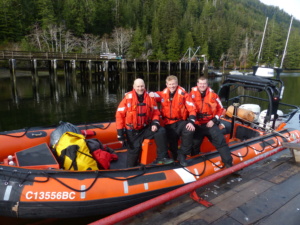
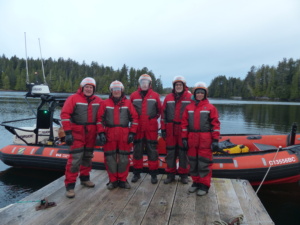
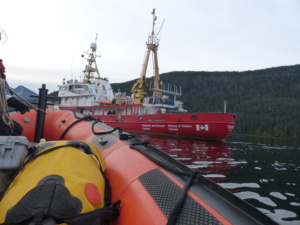 Along the way the W2R team was offered a quick visit onboard the Tanu and to meet the 15-member crew. Search and Rescue is an important aspect of the member’s work. The Tanu maintains close relationships with First Nations along the coast. Often the First Nations communities are the first to react to a sinking or other emergency. When a whale watching vessel sank off Tofino, it was the First Nations skippers who responded first. When the BC Ferries Queen of the North sank near Hartley Bay, it was local villagers who were first on the scene.
Along the way the W2R team was offered a quick visit onboard the Tanu and to meet the 15-member crew. Search and Rescue is an important aspect of the member’s work. The Tanu maintains close relationships with First Nations along the coast. Often the First Nations communities are the first to react to a sinking or other emergency. When a whale watching vessel sank off Tofino, it was the First Nations skippers who responded first. When the BC Ferries Queen of the North sank near Hartley Bay, it was local villagers who were first on the scene.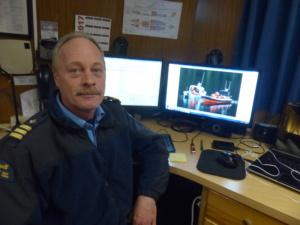 The Coast Guard joins the RCMP, BC Ferries, Britco Structures, Telus, Bandstra, Rotary District 5040, Windsor Plywood, Nanaimo Correctional Centre and numerous small businesses as a member of the Write to Read team.
The Coast Guard joins the RCMP, BC Ferries, Britco Structures, Telus, Bandstra, Rotary District 5040, Windsor Plywood, Nanaimo Correctional Centre and numerous small businesses as a member of the Write to Read team.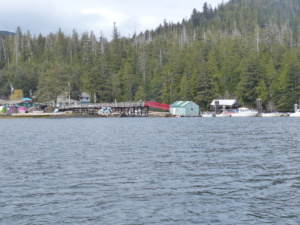 Here’s what Wikipedia says about the little village of Kyquot: The Kyuquot/Cheklesath First Nation (officially Ka:’yu:’k’t’h’/Che:k:tles7et’h’ First Nation) is a First Nations government based at Kyuquot, located on the outer coast of Kyuquot Sound, on the west coast of Vancouver Island in British Columbia, Canada. It is a member of the Nuu-chah-nulth Tribal Council.
Here’s what Wikipedia says about the little village of Kyquot: The Kyuquot/Cheklesath First Nation (officially Ka:’yu:’k’t’h’/Che:k:tles7et’h’ First Nation) is a First Nations government based at Kyuquot, located on the outer coast of Kyuquot Sound, on the west coast of Vancouver Island in British Columbia, Canada. It is a member of the Nuu-chah-nulth Tribal Council.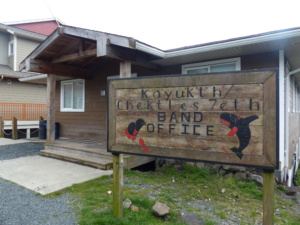 Here is what the Canadian Encyclopedia says about Kyquot: The Kyquot/Cheklesath First Nation, located on the outer coast of Kyquot Sound, on the west coast of Vancouver Island in British Columbia, Canada. As of 2015, the two nations have a combined membership of approximately 600 people, about 150 of whom live on reserve. Like other Nuu-chah-nulth nations, the Kyquot and Checleseht have a strong ceremonial culture, characterized by feasting and entertainment with song, dance, contests and theatricals. They are also known for their stunning woodwork, including canoes, totem poles, multifamily houses and other products hand-crafted out of fine cedar, such as baskets.
Here is what the Canadian Encyclopedia says about Kyquot: The Kyquot/Cheklesath First Nation, located on the outer coast of Kyquot Sound, on the west coast of Vancouver Island in British Columbia, Canada. As of 2015, the two nations have a combined membership of approximately 600 people, about 150 of whom live on reserve. Like other Nuu-chah-nulth nations, the Kyquot and Checleseht have a strong ceremonial culture, characterized by feasting and entertainment with song, dance, contests and theatricals. They are also known for their stunning woodwork, including canoes, totem poles, multifamily houses and other products hand-crafted out of fine cedar, such as baskets.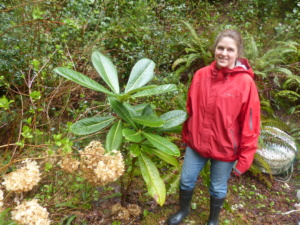 You won’t find Kyquot on most maps. The tiny community is hidden away on the far northwest coast of Vancouver Island. It’s only accessible by water taxi. The remoteness has some fortunate features, including tourism. Fishing is excellent, which means there are several fine (expensive) lodges. The waters near the villages are awash with “rafts” of sea otters, floating sweetly among kelp beds.
You won’t find Kyquot on most maps. The tiny community is hidden away on the far northwest coast of Vancouver Island. It’s only accessible by water taxi. The remoteness has some fortunate features, including tourism. Fishing is excellent, which means there are several fine (expensive) lodges. The waters near the villages are awash with “rafts” of sea otters, floating sweetly among kelp beds. 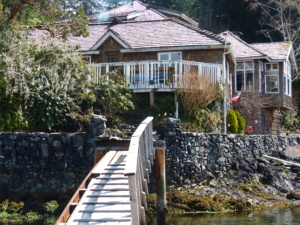 Over the years the Plensky family grew, and so did their house. From time to time they put up passengers from the freight vessel
Over the years the Plensky family grew, and so did their house. From time to time they put up passengers from the freight vessel 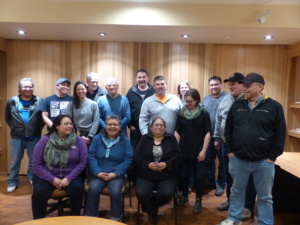 It started off as a library, and then grew like a giant cedar tree. A big group of Write to Read volunteers drove to the very remote village of Kyquot in early April to make a survey. They came back satisfied they have the skills and experience to create what is being billed as The Big Project. The library designed to improve aboriginal literacy has become a full-fledged Learning Centre, part of a Community Centre, which will be located right next to a new Big House. A $50,000 project has evolved into a $5 million project. It may be the model for many more similar projects to come.
It started off as a library, and then grew like a giant cedar tree. A big group of Write to Read volunteers drove to the very remote village of Kyquot in early April to make a survey. They came back satisfied they have the skills and experience to create what is being billed as The Big Project. The library designed to improve aboriginal literacy has become a full-fledged Learning Centre, part of a Community Centre, which will be located right next to a new Big House. A $50,000 project has evolved into a $5 million project. It may be the model for many more similar projects to come.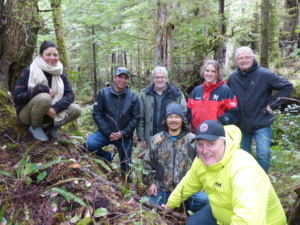 The W2R team toured the village with architect Scott Kemp and it was decided the original site for the planned library was too close to sea level and at threat from any tsunami. An alternative site had been scoped out, so the entire team trudged up the hill past the school to the site of a planned new sub-division. The engineers decided an up close inspection was required and the entire team bushwhacked into virgin forest, where the biomass underneath was 10-feet deep.
The W2R team toured the village with architect Scott Kemp and it was decided the original site for the planned library was too close to sea level and at threat from any tsunami. An alternative site had been scoped out, so the entire team trudged up the hill past the school to the site of a planned new sub-division. The engineers decided an up close inspection was required and the entire team bushwhacked into virgin forest, where the biomass underneath was 10-feet deep.









